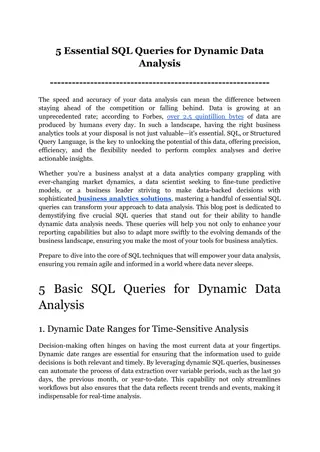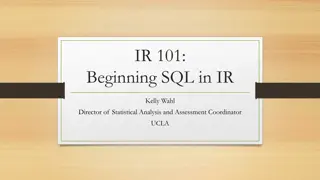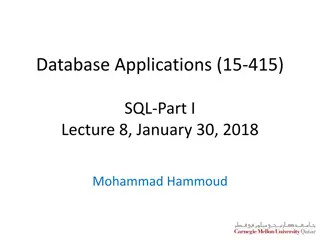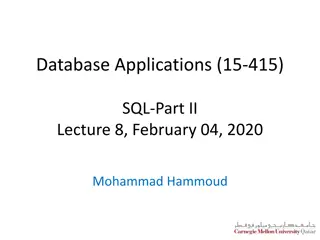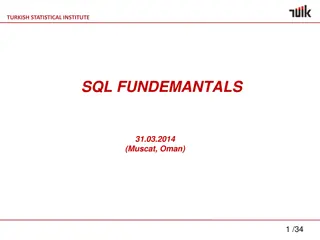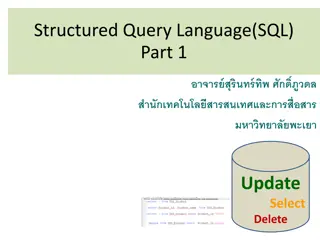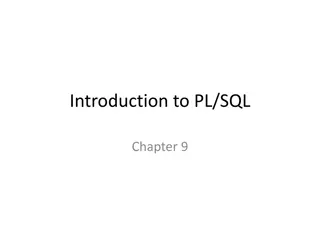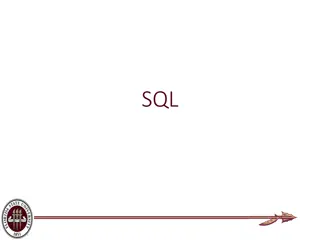Understanding SQL Functions for Database Queries
SQL functions are essential elements in performing actions and obtaining results in a database query. They come in two main types: scalar functions and aggregate functions. Scalar functions operate on single values, while aggregate functions operate on sets of data. Examples of SQL functions include mathematical functions like POWER and ROUND, as well as text functions like UPPER and LOWER. By incorporating these functions in SQL commands, users can efficiently manipulate data for reporting and analysis purposes.
Download Presentation

Please find below an Image/Link to download the presentation.
The content on the website is provided AS IS for your information and personal use only. It may not be sold, licensed, or shared on other websites without obtaining consent from the author. Download presentation by click this link. If you encounter any issues during the download, it is possible that the publisher has removed the file from their server.
E N D
Presentation Transcript
SQL functions Chapter 4 Database query using sql functions Informatics Practices Class XII (As per CBSE Board)
SQL functions Basically, it is a set of SQL statements that accept only input parameters, perform actions and return the result. A function can return an only a single value or a table. Functions are not alternate to sql commands but are used as a part of sql command(generally select command). Types of Function(System defined) A scalar function is a function that operates on scalar values -- that is, it takes one (or more) input values as arguments directly and returns a value.Maths,text, date functions etc. These functions can be applied over column(s) of a table to perform relevant operation on value of each record. For e.g. select left(name,4) from student; Will display 4 left side letters of each row of name field from student table. An aggregate function is a function that operates on aggregate data -- that is, it takes a complete set of data as input and returns a value that is computed from all the values in the set. E.g. max(), min(), count(), sum(), avg().Generally these are used for report preparation & mostly used with group by and having clause.
SQL functions Mathematical functions Perform operation over numeric value POWER() power() returns the value of a number raised to the power of another number. The synonym of power() is pow(). Syntax - pow(m,n) A number which is the base of the exponentiation. A number which is the exponent of theexponentiation. n E.g. Mysql> select pow(2,3); Mysql>8 Mysql> selectpow(2.37,3.45); Mysql>19.6282 m
SQL functions Mathematical functions ROUND() the round() function returns a number rounded to a certain number of decimal places. Syntax - ROUND(column_name,decimals) column_name -Required. The field to round. decimals -Required, Specifies the number of decimals to be returned. Decimal places position value is rounded to next integer ,if its next right side number is>=5 Default decimal place is 0 position if we not specify
SQL functions Mathematical functions MOD() The MOD() function returns the remainder of one number divided by another. The following shows the syntax of the MOD() function: Syntax - MOD(dividend,divisor) Dividend - is a literal number or a numeric expression to divide. Divisor- is a literal number or a numeric expression by which to divide the dividend. E.g. Mysql> SELECT MOD(11, 3); Mysql>2 Mysql> SELECT MOD(10.5, 3); Mysql>1.5
SQL functions Text functions- Perform operation over string values. UPPER() UPPER(str) Returns the string str with all characters changed to uppercase. mysql> SELECT UPPER( Tej'); -> TEJ' UCASE(str)-UCASE() is a synonym for UPPER(). LOWER(str)-Returns the string str with all characters changed to lowercase mysql> SELECT LOWER('QUADRATICALLY'); ->'quadratically LCASE(str) LCASE() is a synonym for LOWER().
SQL functions Textfunctions- Perform operation over string values. SUBSTRING(str,pos) - SUBSTRING(str FROM pos), SUBSTRING(str,pos,len)- SUBSTRING(str FROM pos FOR len) The forms without a len argument return a substring from string str starting at position pos. The forms with a len argument return a substring len characters long from string str, starting at position pos. The forms that use FROM are standard SQL syntax. It is also possible to use a negative value for pos. In this case, the beginning of the substring is pos characters from the end of the string, rather than the beginning. mysql> SELECT SUBSTRING( practically',5); -> 'tically' mysql> SELECT SUBSTRING('foofarbar' FROM 4); -> farbar' mysql> SELECT SUBSTRING('Quadratically',5,6); -> 'ratica' mysql> SELECT SUBSTRING( Aakila', -3); -> 'ila' mysql> SELECT SUBSTRING( Aakila', -5, 3); -> 'aki' mysql> SELECT SUBSTRING( Aakila' FROM -4 FOR 2); -> 'ki' MID(str,pos,len) MID(str,pos,len) is a synonym for SUBSTRING(str,pos,len),substr()
SQL functions Text functions- Perform operation over string values. LENGTH(str) - Returns the length of the string str mysql> SELECT LENGTH('text'); -> 4 LEFT(str,len) - Returns the leftmost len characters from the string str, or NULL if any argument is NULL. mysql> SELECT LEFT( Toolbar', 4); -> Tool RIGHT(str,len)-Returns the rightmost len characters from the string str, or NULL if any argument is NULL. mysql> SELECT RIGHT( Toolbar', 3); -> 'bar'
SQL functions Text functions- Perform operation over string values. INSTR(str,substr)-Returns occurrencee of substring substr in string str. mysql> SELECT INSTR( Toobarbar', 'bar'); -> 4 mysql> SELECT INSTR('xbar', ybar'); -> 0 the position of the first
SQL functions Text functions- Perform operation over string values. LTRIM(str)-Returns the string str with leading space charactersremoved. mysql> SELECT LTRIM(' Toolbar'); -> Toolbar RTRIM(str)-Returns the string str with trailing space characters removed. mysql> SELECTRTRIM( Toolbar '); -> Toolbar TRIM([{BOTH | LEADING | TRAILING} [remstr] FROM] str)- Returns the string str with all remstr prefixes or suffixes removed. If none of the specifiers BOTH, LEADING, or TRAILING is given , BOTH is assumed. mysql> SELECTTRIM(' tool '); -> 'bar' mysql> SELECT TRIM(LEADING 'x' FROM'xxxtoolxxx'); -> toolxxx' mysql> SELECT TRIM(BOTH 'x' FROM'xxxtoolxxx'); -> tool' mysql> SELECT TRIM(TRAILING 'xyz' FROM toolxxx'); -> tool'
SQL functions Date functions- Perform operation over date values. NOW()-Returns the current date and time as a value in 'YYYY-MM-DD hh:mm:ss' or YYYYMMDDhhmmss format, depending on whether the function is used in string or numeric context. mysql> SELECT NOW(); -> '2020-04-05 23:50:26' mysql> SELECT NOW() + 0; -> 20200415235026.000000 Here +0 means +0 second DATE(expr)-Extracts the date part of the date or datetime expression expr. mysql> SELECT DATE('2003-12-31 01:02:03'); -> '2003-12-31'
SQL functions Date functions- Perform operation over date values. MONTH(date)-Returns the month for date, in the range 1 to 12 for January to December, or 0 for dates such as '0000-00-00' or '2008-00-00' that have a zero month part. mysql> SELECT MONTH('2008-02-03'); -> 2 MONTHNAME(date)-Returns the full name of the month for date. mysql> SELECT MONTHNAME('2008-02-03'); -> 'February
SQL functions Date functions- Performoperation over date values. YEAR(date)-Returns the year for date, in the range 1000 to 9999, or 0 for the zero date. mysql> SELECT YEAR('1987-01-01'); -> 1987 DAY(date)-Returns the day of the month for date, in the range 1 to 31, or 0 for dates such as '0000-00-00' or '2008-00-00' that have a zero day part. mysql> SELECT DAYOFMONTH('2007-02-03'); -> 3 DAYNAME(date)-Returns the name of the weekday for date. mysql> SELECT DAYNAME('2007-02-03'); -> 'Saturday'
SQL functions Aggregate Functions & NULL- Perform operation over set of values Consider a table Emp having following recordsas- Null values are excluded while (avg)aggregate function is used Emp Code Name E1 Mohak E2 Anuj E3 Vijay E4 Vishal E5 Anil Result ofquery 12000 3500 4500 3 4000 5 Sal NULL 4500 NULL 3500 4000 SQLQueries mysql> Select Sum(Sal) from EMP; mysql> Select Min(Sal) from EMP; mysql> Select Max(Sal) from EMP; mysql> Select Count(Sal) from EMP; mysql> Select Avg(Sal) from EMP; mysql> Select Count(*) from EMP;


